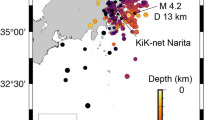Abstract
The common reflection surface (CRS) stack method is known as a generalized stacking velocity analysis tool and was originally introduced as a data-driven method to simulate zero-offset sections. However, this method has some difficulties in imaging complex structures and low-quality data. The problem of conflicting dips is one of the drawbacks of the CRS method addressed in many studies. The common diffraction surface (CDS) method was explicitly introduced to overcome this problem. In one study, the problem was resolved by combination of the CDS method and the common offset CRS method. The method was called the common offset CDS method showed successful application on improving image quality in semi-complex media. In this study, we combined the partial CRS with the CDS to derive the partial CDS for more efficient resolve of the conflicting dips problem. In the partial CDS, thresholds in the angle spectrum were removed for full contribution of all possible dips to have volume of operators for a sample point. The aperture definition in the partial CDS is the same as in the partial CRS, where an offset and time variant aperture is used. The new method was applied on a simple synthetic data set with much diffraction points imbedded in the model. Then it was applied to a semicomplex data set to enhance the body of mud volcanoes and faults. For better comparison, it was applied to two more real data sets from a complex overthrust zone to improve the seismic quality and remove the geological ambiguities in the interpretation. In the synthetic data example, more conflicting dips were resolved than in the other methods. In all real data examples, the enhanced partial CDS data were depth-migrated to compare them with the pre-stack depth migration of partial CRS gathers. More details of the geological structures can be observed in the new results.
Similar content being viewed by others
References
Baykulov M., 2009. Seismic Imaging in Complex Media with the Common Reflection Surface Stack. PhD Thesis. Hamburg University, Hamburg, Germany.
Baykulov M. and Gajewski D., 2009. Prestack seismic data enhancement with partial commonreflection-surface (CRS) stack. Geophysics, 74, 49–58.
Bergler S., 2001. The Common Reflection Surface Stack for Common Offset, Theory and Application. MSc Thesis. University of Karlsruhe, Karlsruhe, Germany.
de Bazelaire E., 1988. Normal moveout revisited: inhomogeneous media and curved interfaces. Geophysics, 53, 143–157.
Duveneck E., 2004. Velocity model estimation with data-derived wavefront attributes. Geophysics, 69, 265–274.
Garabito G., Oliva P.C. and Cruz J.C.R., 2011. Numerical analysis of the finite offset common reflection surface traveltime approximations. J. Appl. Geophys., 74, 89–99.
Gelchinsky B., Berkovitch A. and Keydar S., 1999. Multifocussing homeomorphic imaging: Part 1, Basic concepts and formulas. J. Appl. Geophys., 42, 229–242.
Heilmann Z., 2007. CRS Stack Based Seismic Reflection Imaging for Land Data in Time and Depth Domain. PhD Thesis. University of Karlsruhe, Karlsruhe, Germany.
Hertweck T., Jäger C., Mann J., Duveneck E. and Heilmann Z., 2004. A seismic reflection imaging workflow based on the common reflection surface (CRS) stack: theoretical background and case study. SEG Technical Program Expanded Abstracts 2004, 2032–2035, DOI: 10.1190/1.1845195.
Höcht G., Ricarte P., Bergler S. and Landa E., 2009. Operator oriented CRS interpolation. Geophys. Prospect., 57, 957–979.
Hubral P., 1999. Macro model independent seismic reflection imaging. J. Appl. Geophys., 42, 137–146.
Jäger R., 1999. The Common Reflection Surface Stack: Theory and Application. MSc Thesis. University of Karlsruhe, Karlsruhe, Germany.
Landa E., Fomel S. and Moser T.J., 2006. Path-integral seismic imaging. Geophys. Prospect., 54, 491–503.
Mann J., 2001. Common reflection surface stack and conflicting dips. Extended Abstract. 63rd EAGE Conference & Exhibition 2001. EAGE Publications, EAGE, Houten, The Netherlands.
Mann J., 2002. Extensions and Applications of the Common-Reflection-Surface Stack Method. PhD Thesis. University of Karlsruhe, Karlsruhe, Germany.
Müller T., 1998. Common reflection surface stack versus NMO/DMO/STACK. Extended Abstract. 60th EAGE Conference & Exhibition 1998. EAGE Publications, EAGE, Houten, The Netherlands, DOI: 10.3997/2214-4609.201408166.
Müller T., 1999. The Common Reflection Surface Stack Method: Seismic Imaging without Explicit Knowledge of the Velocity Model. PhD Thesis. University of Karlsruhe, Karlsruhe, Germany.
Shahbazi A., Ghosh D., Soleimani M. and Gerami A., 2016. Seismic imaging of complex structures with the CO-CDS stack method. Stud. Geophys. Geod., 60, DOI: 10.1007/s11200-015-0452-6 (in print).
Shahsavani H., Mann J., Piruz I. and Hubral P., 2011. A model based approach to the common diffraction surface stack. Extended Abstract. 73rd EAGE Conference & Exhibition 2011. EAGE Publications, EAGE, Houten, The Netherlands, DOI: 10.3997/2214-4609.20149417.
Soleimani M. and Mann J., 2008. Merging aspects of DMO correction and CRS stack to account for conflicting dip situations. Annual WIT Report, 159-166 (http://wit.zmaw.de/fileadmin /user_upload/wit/reports/AnnualReport_2008.pdf).
Soleimani M., Piruz I., Mann J. and Hubral P., 2009a. Solving the problem of conflicting dips in common reflection surface (CRS) stack. Extended Abstract. Shiraz 2009 - 1st EAGE International Petroleum Conference and Exhibition. EAGE Publications, EAGE, Houten, The Netherlands, DOI: 10.3997/2214-4609.20145889.
Soleimani M., Piruz I., Mann J. and Hubral P., 2009b. Common reflection surface stack; accounting for conflicting dip situations by considering all possible dips. J. Seism. Explor., 18, 271–288.
Soleimani M., Mann J., Adibi E., Shahsavani M. and Piruz I., 2010. Applying the CRS stack method to solve the problem of imaging of complex structures in the Zagros overthrust, south west Iran. Extended Abstract. 72nd EAGE Conference & Exhibition 2010. EAGE Publications, EAGE, Houten, The Netherlands, DOI: 10.3997/2214-4609.201401297.
Soleimani M., Adibi E. and Mann J., 2011. Imaging in complex structures by post-stack time migration and CRS stack. Expanded Abstract. 12th International Congress of the Brazilian Geophysical Society & EXPOGEF, Rio de Janeiro, Brazil, 15-18 August 2011. 1024-1026, DOI: 10.1190/sbgf2011-212.
Yang K., Chen B.S., Wang X.J., Yang X.J. and Liu J.R., 2012. Handling dip discrimination phenomenon in common reflection surface stack via combination of output imaging scheme and migration/demigration. Geophys. Prospect., 60, 255–269.
Author information
Authors and Affiliations
Corresponding author
Rights and permissions
About this article
Cite this article
Soleimani, M., Rafiei, M. Imaging seismic data in complex structures by introducing the partial diffraction surface stack method. Stud Geophys Geod 60, 644–661 (2016). https://doi.org/10.1007/s11200-015-0942-6
Received:
Revised:
Accepted:
Published:
Issue Date:
DOI: https://doi.org/10.1007/s11200-015-0942-6




